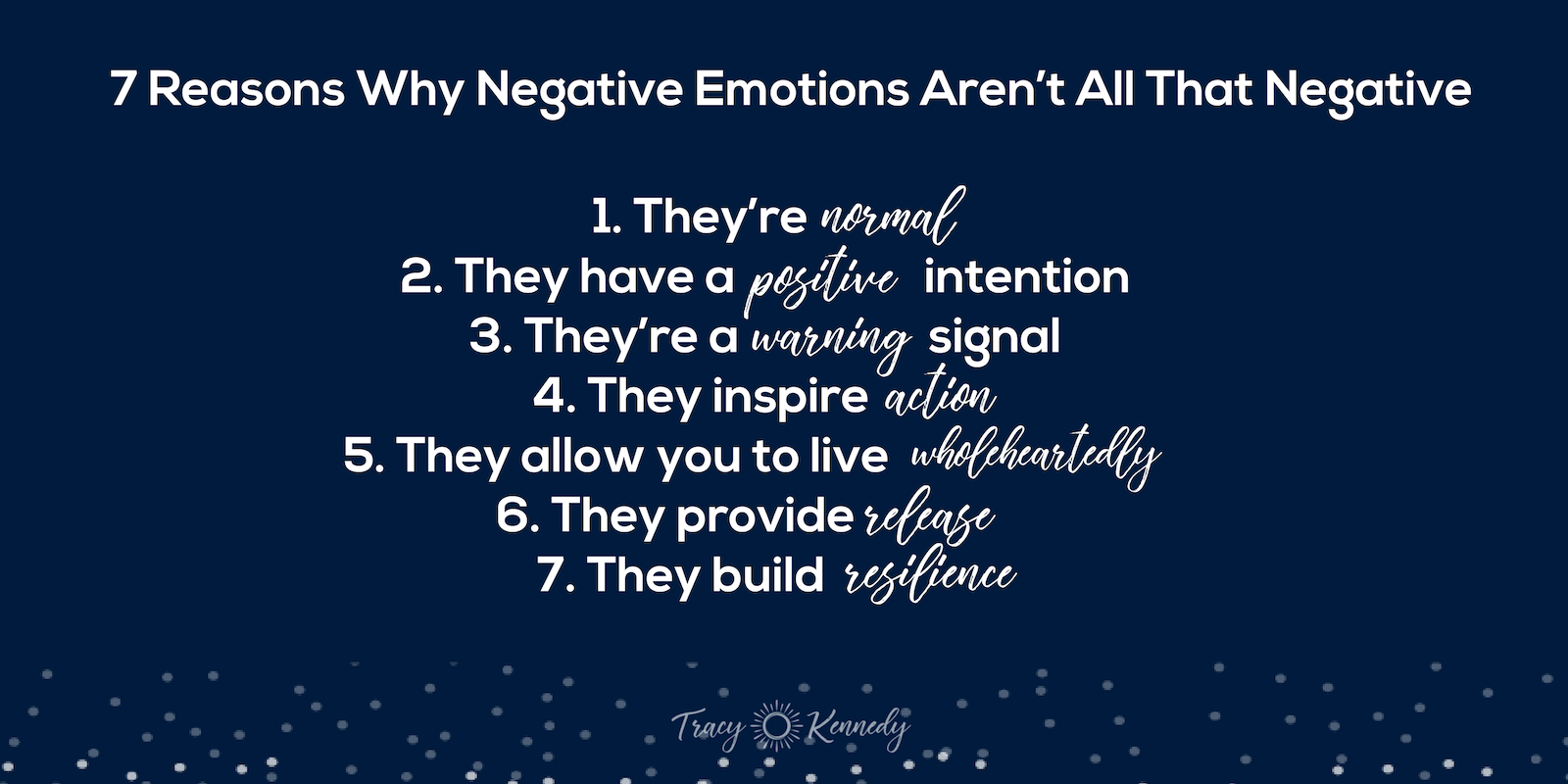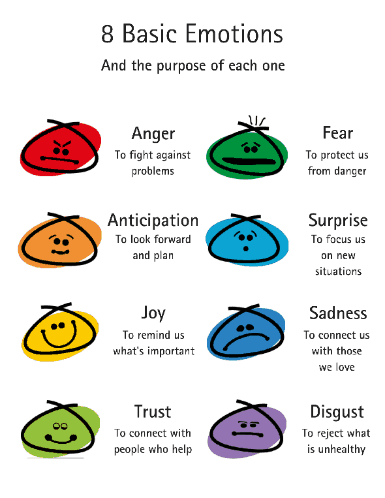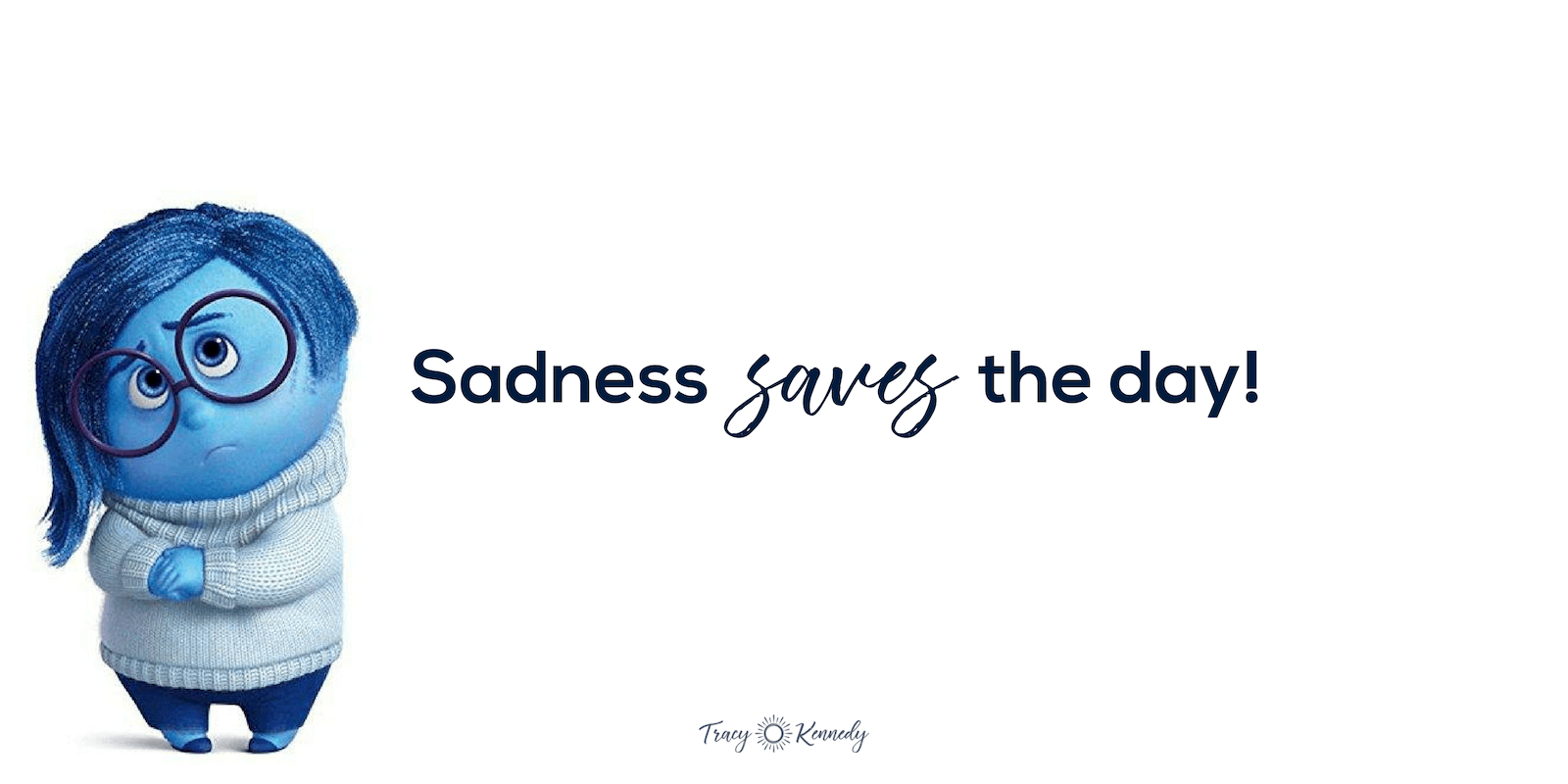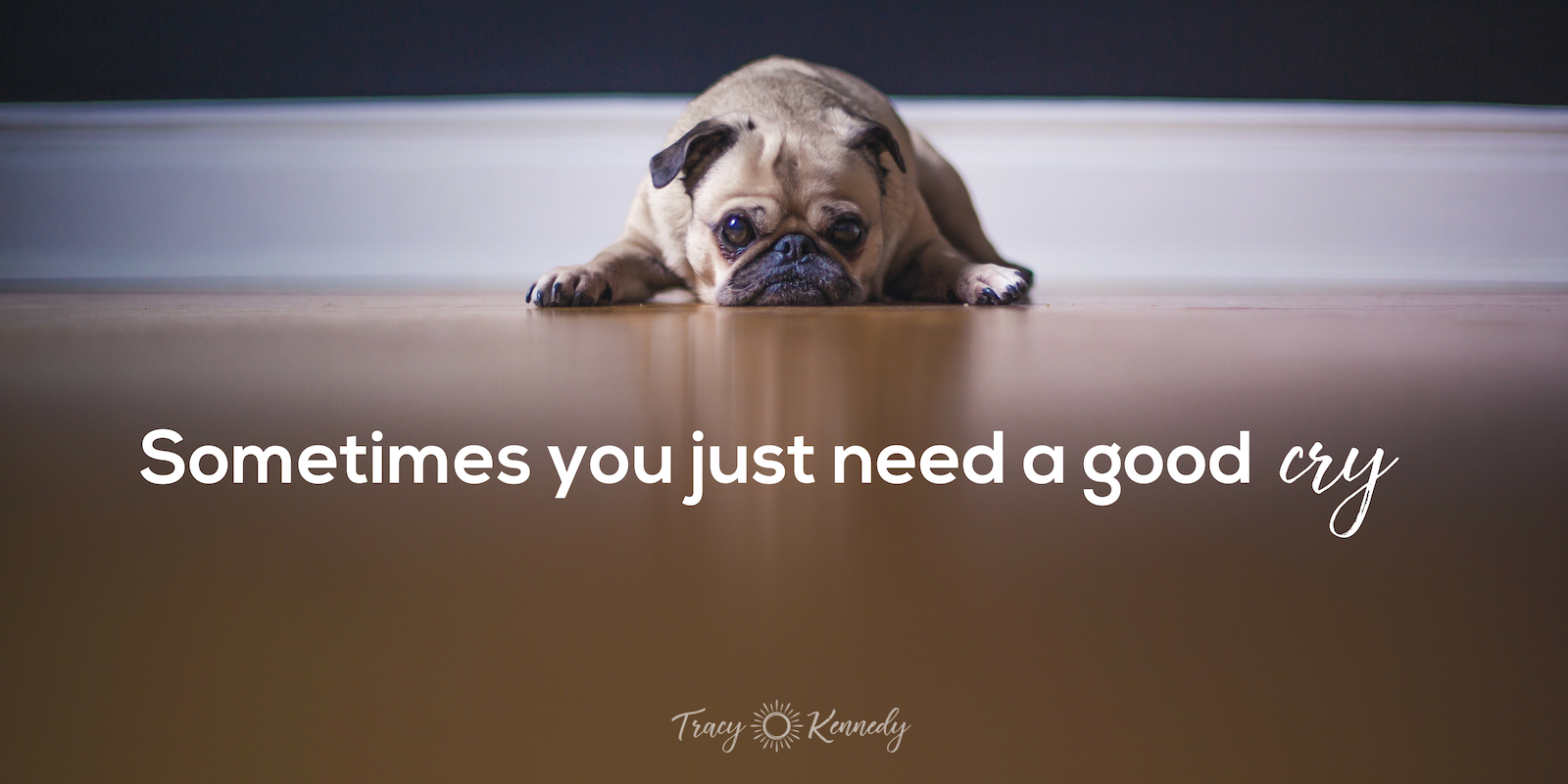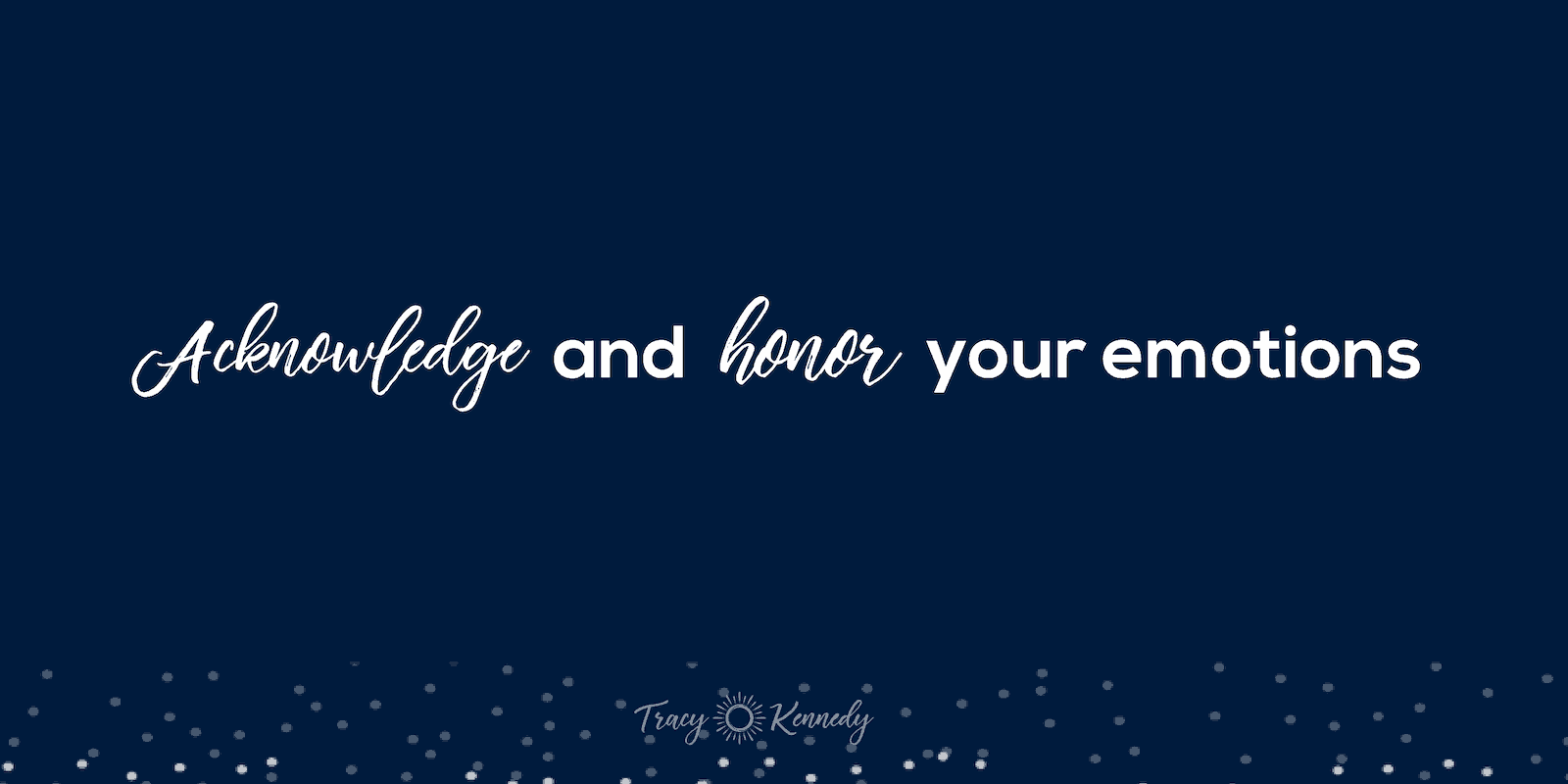I have always had an adverse reaction to negative emotions. I never liked feeling sad, mad or scared. I prefer things to be positive and cheerful – some would say rainbows and sunshine. A lot of this has to do with my upbringing; I grew up in a family who focused on being positive, encouraging and optimistic.
When I was upset, I looked at the bright side. When I was scared, I pushed through it. When I was sad, I got over it. It’s not that I’ve had an easy life, devoid of heartbreak, grief and challenges. I’ve had plenty of those. It’s just that I never decided to focus on that side of things. I thought it was all good. Until it wasn’t.
Several years ago, I found myself facing anxiety for the first time. And not just a little anxiety. We’re talking paralyzing, full-on panic that I had no control over. At one point, I didn’t want my husband to leave for work in the morning. If you’ve ever suffered from anxiety, you know how hard this can be. As someone who has always been adventurous, rarely felt the full force of fear and wired for positivity, this was NOT me and I had no idea what to do.
What I learned (that I have always known, but maybe never fully understood) as I worked through that anxiety, was that it was a symptom. A symptom that something wasn’t working in my life. It was nature’s way of telling me I was off track. There was too much on my plate, I wasn’t taking great care of myself and I needed to slow down.
I may not have slowed down if I wasn’t hit by this spiritual 2×4 of negative feelings. I may have been able to push through many of the ‘negative’ emotions in my life, but some of them were really just pushed down.
I’ve come to learn that negative emotions are neither good nor bad. They are not actually negative; they just feel that way. They are part of life, of being human.
We need to provide space to allow that life is going to be difficult, challenging and incredibly hard sometimes, which leads to uncomfortable or negative emotions. We need to learn to acknowledge, embrace and understand what those emotions are trying to tell us. We need to learn the power and value of these emotions.
Before we dive into this further, I want to make sure you know I am not a therapist or psychologist. These are my experiences of negative emotions for myself, hundreds of people I’ve worked with, and from research and learnings I’ve had over the years. I want to honor and not underestimate the complexity of human emotions. They have been studied by philosophers, psychologists and scientists for thousands of years – each with their own and often competing theories.
With that said, let’s take a look some negative emotions, why they aren’t so negative after all and how to embrace them to live a more fulfilled life.
Table of Contents
What Are Negative Emotions?
Negative emotions are any emotions that cause you to feel badly in one way or another. Anger, fear, sadness, despair, frustration, guilt, shame, disgust, disappointment…You name it. We all feel these emotions. Whether you acknowledge them or not, they are there.
In the 1970’s, psychologist Paul Eckman (best known for studying facial expressions and how they relate to emotions) identified six basic emotions: happiness, sadness, disgust, fear, surprise and anger. Interesting that four out of six of these fall into the ‘negative’ category.
In 1980, Psychologist Robert Plutchik identified eight basic emotions: joy, sadness, trust, disgust, fear, anger, anticipation and surprise. Again, four of these eight might be considered negative.
They both went on to expand the range of emotions to include many others. Dr. Plutchik expanded his findings through the wheel of emotions (below) to illustrate the spectrum, degrees and relationships among these emotions.
If you Google it, you could find a list of the top 10, top 20 and more emotions, but for the sake of our sanity, we can start with these.
Why Negative Emotions Aren’t All That Negative
While negative emotions may feel bad, they’re not so bad for us after all. Here are seven reasons why negative emotions aren’t all that bad.
1. They’re Normal.
We are going to start here, because, somewhere along the way, experiencing negative emotions became a bad thing. In a world where we are encouraged to be present, grateful and happy (which I agree with as well), perhaps we are doing ourselves a disservice by not talking about the fact that negative emotions are a natural and unavoidable part of life.
This leads us to feel even worse when we do feel them. Experiencing different ‘moods’ is all part of being human.[1]
It’s time to re-assess the role of bad moods in our lives. We should recognize they are a normal and even useful and adaptive part of being human; they help us cope with many everyday situations and challenges.
2. They Serve a Purpose and Have a Positive Intention.
If you research the underlying purpose behind negative emotions, they all have one thing in common:
They have served an evolutionary purpose for our survival, health or well-being.
For example, fear is our signal that something is wrong and protects us from danger and allows us to survive. Sadness enhances feelings of connection and empathy and builds community. Disgust provides an adverse reaction and steers us away from things that could cause harm or be contagious. Shame and guilt urge us to do the right thing and correct our wrongs. Anger is a protection mechanism that inspires action and causes us to do something to change a situation.[2]
Surely, without these emotions, we would not be where we are as a species. All these emotions are things we need to feel attuned to help us survive and grow. While they may feel negative, they all have an underlying, positive intention, a reason for being. We need to seek to identify what that positive intention is.
In addition, our negative emotions prompt us to grow. To be better partners, better friends. To grow, progress. They make us better people and drive change in our lives.
3. They’re a Warning Signal.
They identify something that’s going on — our true self, our inner nature and natural state is one of peace, calm and connection.
However, when we’re out of alignment with our natural and best way, we experience negative emotions as signals that we’re off track. They are telling us, “Hey, listen up, somethings not right here, you’re going off track”.
‘Milder’ negative emotions such as frustration, apprehension or annoyance can be early warning signals that something’s not working for you. Leave those alone long enough and they’ll start to get louder. Perhaps you’ll start to feel anger, resentment or fear. Leave those alone too long and they’re out of control – you may experience rage, loathing, anxiety, depression.
I always liken this to a toddler who needs your attention. They’ll tug on your leg quietly seeking your attention. If you ignore them or don’t pay attention, they start to whine. Ignore them further, or push their needs to the side, you’ll start to get screaming, crying and eventually a full-on temper tantrum.
The fear and anxiety I experienced was a (late) warning signal that the path I was on was unsustainable, even if my conscious mind thought I was all ‘all good’. I was way off track and needed to slow down.
Some negative emotions aren’t signs we are off track or out of alignment, but signs we are doing the wrong thing. Think about when you feel shame or guilt. These are signals that you’re doing the ‘wrong thing’ or something out of integrity. A few weeks ago, my 7-year-old daughter came home saying she felt ashamed of something. That was a strong word to use and my first reaction was to comfort her to remove that awful feeling.
But then I asked her why. As she explained what happened, I realized that what she was feeling was quite healthy. The guilt was telling her she was doing the wrong thing – in this case, it was a self-correcting mechanism. Our discussion became less about absolving the bad feeling and more about learning from her mistakes and doing the ‘right thing’ next time.
4. They Inspire Action.
They are a catalyst for change and movement. What happens when you get really mad? You take action.
Maybe you get passed up for the latest promotion. You’re mad. You felt you deserved it and you’re angry you didn’t get it. That anger prompts you to talk to your boss (in a courteous and professional way, of course) about your skills, accomplishments, successes so she can see your point of view and doesn’t pass you by next time.
Perhaps you wouldn’t have spoken up so clearly if you weren’t angry?
Anger has been used throughout history as a positive catalyst for change. Many great leaders have harnessed their anger to stand up for what they believe in and to demand justice and change. Martin Luther King Jr. said,
“The supreme task is to organize and unite people so that their anger becomes a transforming force.”
Our anger can be a transforming force for good on a small, person scale (as in the case above) and a much more widespread scale (such as Dr. King). When someone treats you or others unfairly, and you feel angry, you can harness that anger to stand up and correct the situation.
Negative emotions create fire in your belly – they motivate you to be productive, solve problems, stand up for what you believe in, gain back your personal power and make changes that propel you – or maybe even society – in a different direction.
I love this quote from Arun Gandhi (grandson of Mahatma Gandhi):
“Use your anger for good. Anger to people is like gas to the automobile – it fuels you to move forward and get to a better place. Without it, we would not be motivated to rise to a challenge. It is an energy that compels us to define what is just and unjust.”
5. They Allow You to Live Wholeheartedly.
Many of the world’s ancient wisdom traditions, philosophers and psychologists have valued and been intrigued by the light-dark, negative-positive, shadow aspects of our selves.
Think about the concept of yin and yang in Chinese philosophy:[3]
“It describes how seemingly opposite or contrary forces may actually be complementary, interconnected, and interdependent in the natural world, and how they may give rise to each other as they interrelate to one another.”
You know the movie Inside Out? I’m embarrassed to admit this, but I’ll share it anyway. When the movie first came out, I didn’t want my kids to see it. Why? Because I didn’t want any emphasis placed on ‘negative’ emotions: fear, anger and sadness. Why couldn’t they just make a movie about JOY? Joy is awesome. Add in happy, grateful and excited and now we have a movie I want to take my kids to see.
Then I watched Brene Brown’s TED talk on vulnerability, and it hit me like a ton of bricks. Maybe it wasn’t until then that I fully realized how important it is to feel all of our emotions. In her talk, she shares that to live wholeheartedly, we must feel the full range of emotions. The positive: joy, gratitude, happiness. And the not so positive: grief, fear, shame, disappointment.
You can’t selectively feel emotion. So, for us to live as wholehearted human beings, we need to feel and express our full range of emotions. After all, how can you really appreciate the joy of happiness if you haven’t suffered the pain of sadness?
And as my daughter reminded me, in the movie Inside Out, guess who saves the day? Sadness. Yes, it’s sadness who saves the day.[4]
6. They Provide Release.
“What the mind conceals, the body reveals”.
When we conceal or try to hide or ignore emotions, they don’t just go away. They go deep within us. They eat at us. They cause ulcers, back pain, sickness. That ‘sudden’ heart attack, ‘unexplained’ high blood pressure or ‘unexpected’ anxiety may not be so inexplicable after all.
Feeling our emotions allows us to release the feeling and move forward. My chiropractor, Dr. Ruth Ziemba once said,[5]
“Feel them, but don’t let them become you.”
This has served me well. I think we have all feared those painful emotions of guilt, anger, grief, hopelessness would mean we would fall into a never-ending pit of despair from which may never emerge.
I have worried I would go too far down the rabbit hole and never make it back to see the light of day. But in order to move on, we must feel and release them. Once we ‘expose’ them, they have much less control over us.
Rich Roskopf,[6] a bodyworker , trainer, massage and movement specialist, shared something that resonated deeply with me. He was studying the meditation work of Guy Armstrong, author of “Emptiness” and the philosophy that everything needs to arise, persist and pass.
The same is true for our emotions. When we allow the feelings to arise and persist, they will pass. Grasping, clinging and pushing them down will always lead to unhappiness.
Even a good cry can help. We have three different types of tears and the ones produced when we cry can make you feel better. Tears cried in sadness contain a chemical that is toxic to our body.[7]
“Emotional crying is the body’s way of ridding itself of these toxins and waste products.”
In Japan, they even have ‘crying rooms’ and ‘crying events’ which serve to help participants ease stress levels and release emotion.
7. They Build Resilience.
The more you experience the full range of emotions, the more resilient you become to facing and dealing with them.
Jessie Dudley, Licensed Clinical Social Worker and Program Manager at the Mental Health Center of Denver, had this to say.
“By allowing yourself to feel everything you need to feel, you learn how to cope and build your toolbox of coping strategies. Then, next time you feel that same feeling, you know what to do and what works for you. You realize the feeling won’t kill you. It doesn’t’ make the sensation any less, but it makes you more aware of how to respond to it.
If you don’t build coping skills, when you feel those emotions, you want to push them away. Emotional avoidance is effective to an extent. Really, everybody tries to avoid feeling badly. But the more you avoid, the less coping skills you’re developing. The less you are able to cope, the more afraid you become of the emotions, which leads to a vicious cycle of pushing them down. In many cases, people may turn to other unhealthy ways to cope, including addictions and substance abuse.
Remember this: we are constantly evolving. Your coping skills will evolve and grow too.”
As Jessie shared, When you face negative emotions and learn effective coping skills, you feel stronger and more capable to deal with them in the future.
As a mother, this is particularly relevant. I once read that our job as parents is not to protect our kids from disappointment, it’s to be there for them when disappointment happens. If our kids don’t learn healthy ways to cope with negative emotions, they will struggle throughout life to manage them.
How to Embrace Negative Emotions and Turn Them into Positive Motivation
Here’s a process you can use. Let’s call it the ACDC Method.
A – Acknowledge and Honor the Emotion
Feel it but don’t let it become you. Let it arise, persist and pass. Sit with it. Your instinct will be to push it away. (Seriously, who wants to feel like crap?)
But once you acknowledge it, you can move forward. If you feel uncomfortable or unsafe feeling what’s coming up, you may want to reach out to a therapist or someone who can create a safe space to experience your emotions.
C – Consider the Positive Intention of the Emotion
Is it showing up as an early warning signal (or a late one), a catalyst for positive change, a protection or survival mechanism?
Identify the positive intention behind the emotion.
D – Double Check Your Story
Sometimes our negative emotions are warranted, but sometimes they are misplaced. Make sure to check them out.
If you’re feeling worried, is there really something to worry about or has worrying become a bad habit? If you’re feeling angry at someone, do you have all the facts? Perhaps it’s a miscommunication or misunderstanding. If you’re feeling sad or defeated, is there a story you keep telling yourself that is not true? Before you dive in, make sure to double check the depth of the water.
C – Choose Your Action
Once you acknowledge, understand and double-check the emotion, think about what action you can take.
Maybe you thank the fear for keeping you safe. Perhaps you harness your anger and stop putting up with something that is impacting your life or health. Maybe you use your frustration to move forward in a new direction. Or, employ your guilt to right a wrong.
In some cases, your action may be to do nothing at all other than feel you’re feeling. That’s okay, too.
When Negative Emotions Become Bad…
It would be remiss of me not to acknowledge the varying levels of negative emotions that can occur.
Too much guilt can be paralyzing. Too much sadness is depression. Too much anger can lead to rage. Too much fear can lead to anxiety.
Experiencing some level of these negative emotions is normal. Experiencing ongoing and excessive levels of these emotions can be a signal that something much deeper needs to be addressed.
If you’re feeling persistent negative emotions or your emotions are significantly interfering with your life, please reach out to your doctor, therapist or specialist for help and support.
Conclusion
To experience all of these emotions is what makes us human.
What if we could take off the label of negative emotions? What if they weren’t bad? What if they were all just emotions? Negative. Positive. Neutral. We have all sorts of different emotions.
Let’s just feel them. Listen to them. Acknowledge, honor, accept them. Seek to understand what they are trying to tell us, so we can harness them to live our best lives.
More Tips About Mastering Your Emotions
- What Is Emotional Intelligence (And How to Develop It)
- 10 Emotional Regulation Skills for a Healthier Mind
- How to Stay Calm and Cool When You Are Extremely Stressed
Featured photo credit: Riccardo Mion via unsplash.com
Reference
| [1] | ^ | The Conversation: Why bad moods are good for you: the surprising benefits of sadness |
| [2] | ^ | 6Second.org: Plutchik’s Wheel of Emotions – 2017 Update |
| [3] | ^ | Wikipedia: Yin and yang |
| [4] | ^ | Musical Essences: Inside Out – Sadness Saves Riley – Ending Scene |
| [5] | ^ | Dr. Ruth Ziemba: What is Integral Wisdom Healing Arts? |
| [6] | ^ | About Rich Roskopf |
| [7] | ^ | How Stuff Works: The Purpose of Crying |


